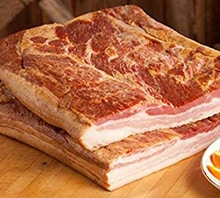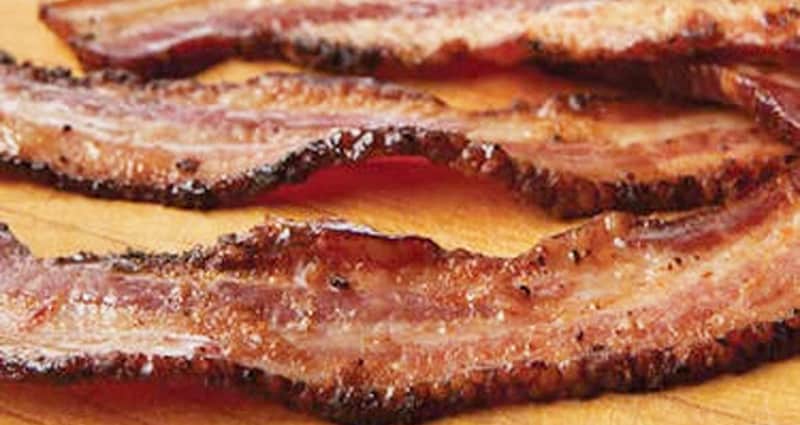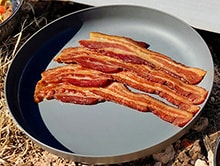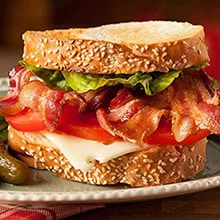
Bacon is a rare food item that can make an entire family come to a complete standstill. It is one of the most popularly asked for food as a standalone or topping on other foods. Once cooked, it becomes a universal garnish and flavoring ingredient that gives food a heartier flavor that we all love.
No matter what flavor it gives, it has been an opinion that Bacon makes everything taste better! It must be the curing process, the smoking of it, and the cut of meat itself – the loin, leaner part of the pig’s back – all combine to make bacon taste irresistible.
Crumbled, it is good on almost anything. If you are curing your bacon, the possibilities are endless. Perhaps homemade bacon rubs taste very lovely as well as a commercial bacon sauce. Therefore, when you precook bacon at once, you can throw it in an oven or grill to reheat when needed.
Read on for the different methods of reheating bacon and other important information such as how to prepare bacon, and more!
Simple Ways to Reheat Bacon
Cut the bacon before you pre-cook because it’s easier than cutting bacon when it’s hot. Note that the pieces will shrink after cooking. Use a skillet because the pieces will be small, and you will not be worried about curling.
The oven is suitable for cooking many full slices to reduce curling, but it takes longer and is more complicated to clean-up.
Get your bacon ready

Start with some decent quality bacon. Get your bacon sliced and laid out flat on parchment paper from the manufacturer. The usual store-bought bacon is sliced and overlapped, causing it to stretch when pulled apart. Layout pack bacon does not do that.
Take an entire sheet of bacon and place it on a large metal cookie sheet or aluminum baking sheet while keeping the bacon on the parchment paper.
Don’t worry, the parchment paper is meant to be used and cooked with the oven’s bacon. A typical “freezer tray” in a restaurant kitchen will hold three of these laid-out sheets.
Preheat your bacon
Preheat the bacon for about ten minutes in a 3500F oven or until it reaches an excellent firmness, but not an overly crisp degree of doneness. Remove the cooked bacon from the oven and lift the bacon pieces onto a paper towel-covered serving tray, or better yet, use a raised screen type of baking rack that fits onto a baking sheet.
Lift the bacon with a flat spatula when placing onto the paper towels or draining rack. Gently shake the grease off the bacon while lifting it from the cooking tray before placing it onto the paper towels.
Neatly stack the bacon layer by layer directly on top of each other. There should not be much sticking if you shook off the excess grease.
Preserve the bacon
The bacon can be held all day virtually at room temperature like this until ready to eat. You can only do this with bacon that is cooked to a firm degree of doneness.
The bacon should almost lay completely flat when picked up individually after cooking. If the bacon is floppy and translucent, it needs to go back in the oven until it is cooked firm but not too brown.

Methods of Cooking Bacon
There are many different methods, so far you have mostly oven or microwave. It’s easy and quick, and you can monitor it to come out the way you prefer.
It does require a little experimenting with timing and how many strips you’re doing at once, but you’ll figure out a technique that works for you.
1. Use a stove
Bacon is either grilled, dry-fried, or fried. It is healthier to dry-fry than fry because only the fat that melts out of the bacon is used. However, you can easily drain your bacon on the kitchen paper before serving whatever method you choose. It’s best for excess fat removal.
Any non-stick skillet or a cast-iron skillet will do an excellent job. It is best for this cooking method. The skillet is good because you can collect the fat for other uses, and the bacon should stay relatively straight and flat, depending on the quality.
A set of tongs must come in handy to hold and flip the hot slices of bacon. This method may take a bit longer because you don’t want to overcrowd the pan, so you cook a few pieces at a time.
With this, you will have the most control over the outcome of what you cooked. It is easier to clean the pan than the grease that dripped onto the bottom of your oven.
- An excellent way to start is to put the bacon in a cold pan. Lay the pieces of strips in the skillet. Then, light your stove and turn on a low flame.
- Once some fat begins to melt into grease, boost the temperature to medium-low. Each side can cook for 1-2 minutes.
- If the bacon starts to curl, loosen it with a thong.
- Flip and turn the bacon when necessary for even cooking and crispiness.
- Drain the cooked pieces by laying them down on a paper towel
- Separate the Bacon fat so your slices too greasy. However, you may choose to strain the bacon fat into a jar for later use. It provides an extra layer of flavor to anything you fry in it.
2. Reheat in a Microwave
Those times when you want a quick breakfast, this method works best. However, you will need many paper towels and might need to spend more effort on cleaning.
Microwaving bacon means easy-to-clean, safer handling, and non-splattering of hot bacon grease.
- Start by lying at least four layers of paper towels in a microwave dish, arrange the bacon, and cover it with another set of paper towels.
- Bake at 3500F, but it depends on how you want your bacon.
- Once it’s done, remove the cooked bacon from the paper towels, so it doesn’t stick.
The fact is microwaves work well with fresh bacon. The high-fat content makes it tasty and crisp.
3. Use an Oven
An oven is a good choice when cooking bacon for a big family or easy meal add-ins. An oven is a made-easy appliance that makes cooking convenient and leaves your stovetop free.
- First, preheat the oven and ensure your bacon is resting on the foil-lined baking sheet.
- If you want your bacon crispier, lay the raw bacon over the cooling rack, set over the baking sheet, and bake for 15-20 minutes. If the bacon is thicker, it may require more time.
- Transfer it to a platter with a tong to drain after the bacon is cooked.
4. Reheat on a Grill
Smoking bacon on a grill is another excellent method if you want crispy bacon. Compared to other cooking methods, grilled bacon tastes better.
- First, preheat the grill to high, and place your bacon to grill.
- Flip both sides after 2–3 minutes of cooking each side. It all depends on how crispy you like your bacon
What is the Best Temperature to Cook Bacon?

Bacon has fat, which is why you should cook at a moderate temperature so that fat can flow out of it without burning the surface. The surface of the beacon will appear done if the temperature is too high.
With too high heat, if you stop cooking when the surface looks done, you will have undercooked bacon on the inside. Sometimes the pan/skillet you are cooking with heats unevenly, so some bacon is cooked faster than the other pieces in the pan/skillet. Medium heat is probably the best.
When the temperature is enough, both the surface and inside get done simultaneously, and the fat content is drained. If you leave the bacon on the heat until the outside of it looks crispy, just like you want it to look when you eat it, it will be overcooked. The best thing to do is remove from heat as soon as it’s close to getting done.
When you take the bacon off the heat and leave it to drain and cool, it gets drier and crispier than it looked in the pan. If you are using an oven, allow the bacon to bake at 400°F and the timer for 20 minutes. At this point, watch it close the first time because it might take a few more or fewer minutes depending on your oven.
What to keep in mind when Cooking Bacon?
It’s hard to get decent bacon if you want a cut of meat that is well cooked and crispy. However, bacon is easy to make as you have the chance to cook to taste. People often make common mistakes when cooking bacon, which results in taste-loss and overcooking. To prevent errors, keep in mind these few things:
Select quality bacon
High-quality bacon will always taste better than low-quality bacon, all other things being equal. Find a good butcher that sells local farm bacon if you can. The difference is worth it. Sometimes it’s cheaper to buy local, and you get better quality.
The reason is bacon curls as it cooks and (especially on the ends) when it curls upward. It’s hard to make sure that part cooks without burning the non-curling part. So, selecting a piece of quality bacon makes a real difference.
Do not over-season your bacon
Bacon itself always tastes good. The problem is that it sometimes degrades or ruins or overwhelms the flavors of other foods. The idea of wrapping delicately flavored food with bacon is excellent.
All you taste is the bacon, so why bother with the other ingredients? Think of your favorite spices and add them just before the bacon is done. No matter what you add, please don’t overdo it. You don’t want something different from the unique flavor bacon possesses.
Cook to get the desired result
If there’s a decent ratio of meat to fat, it is best cooked when laid flat in a pan and gently cooked so the fat renders out and the bacon is poached in its fat. When cooked through, pour off the excess fat and bring the heat up to crisp it.
Lift the bacon with a flat spatula when placing onto the paper towels or draining rack. Gently shake the grease off the bacon while lifting it from the cooking tray before placing it onto the paper towels.
Neatly stack the bacon layer by layer directly on top of each other. There should not be much sticking if you shake off the excess grease.
How to check the Doneness of Bacon?
Do you like your bacon more fatty than crisp? Keep an eye on the color. When the bacon gets browned on one side, flip it over for a few seconds and keep an eye on it – remove it to a layer of paper towels for drainage.
For crispy bacon, the whole piece must be uniformly reddish-brown. This is achieved by repeated flipping, pressing flat, and holding down the bacon’s surface with your spatula when the entire piece is brown/red color and not black. After that, remove it to paper towels.
However, you can cook bacon in many ways. Whether it is dark brown, crunchy, crispy, or barely cooked, slightly pink, and pale brown, you can cook bacon to your taste. Some people prefer it to be almost black, some like it light but crispy, and some like it a little bit soft. These are all good, depending on how you want them.
If bacon still isn’t done (thicker bacon typically takes longer), continue rotating and checking every 5 minutes, until you have the bacon of your dreams.
You get consistently crispy (or floppy) bacon, easy clean-up, no oil burns, no grease getting all over the stove, and you can do other things while it cooks. Drain fat, evacuate bacon to a double layer of paper towels and eat or refrigerate.
F.A.Q.
How long can Reheated Bacon last?
Generally speaking, reheated bacon can last for 3-4 months when refrigerated. However, it contains protein and fats that can quickly develop molds and are affected by bacteria. It will quickly spoil compared to the raw one.
So, the life span of bacon should not exceed two days. Because bacon is cured, it doesn’t have to be refrigerated. If it does, it will start to turn brown, slimy looking. Cooked bacon has been sold in supermarkets a couple of times, unrefrigerated. It has a shelf-life after which it should be disposed of.
The bacon is packed in a way that prevents microbial activity and oxidation. It doesn’t stop them entirely. So, again there’s a limit to its suitability as food.
What is Bacon?

Generally, all pork is referred to as bacon until the sixteenth century. However, bacon is the stomach muscles and fat that retains the intestines of the swine.
It is a part cut from below the rib cage. This is located on both sides below the breast and slightly forward of the rear legs.
It can be a whole large piece. It is mostly sliced in automated slicers with different spacing numbers based on regular, thick, or extra thick slices. Bacon is processed in several different ways, dry-cured, injected, coldly smoked, water bath, etc.
Commercial bacon is ‘cold’ smoked and uncooked, but you can also ‘hot’ smoke bacon, which results in a fully cooked product. Bacon is a fatty pork belly and also has a slightly salty taste.
Is Bacon Healthy?
Bacon can, like any food, be a good diet. As breakfast, bacon is one of the most comfort food of all time! It can be eaten by itself or as toppings for burgers or added to salads. The list is endless!
It can reduce some of the health concerns, but most times is meant to be enjoyed. Just moderate your consumption of it and keep a healthy variety in your overall diet. Bacon is not unhealthy as it contains nutrients essential for human survival.
Bacon contains protein and fat-building calories that help maintain your energy level and a healthy body.
A considerable part of the monounsaturated fats in bacon is high in oleic acid. This is the same nutrient found in olive oil, which is rated as heart-healthy. Bacon is great for low and no-carb diets. It contains high protein and low carb energy that helps satiate your appetite and reduce body weight.
This high level of fat and lots of protein will help you cut down on the urge to overeat and feel full after eating a traditionally small-serving food. Therefore, it boosts your metabolism and builds leaner, stronger muscles.
Conclusion
Bacon is one of the oldest meats cut that many people still crave today. With the level of nutrients it has, it is comparatively healthier than some meat.
Bacon is cooked in various ways but often cured and preserved with salt and molasses. It is primarily smoked and, when cooked right under the appropriate temperature, is crisp and tastes great.